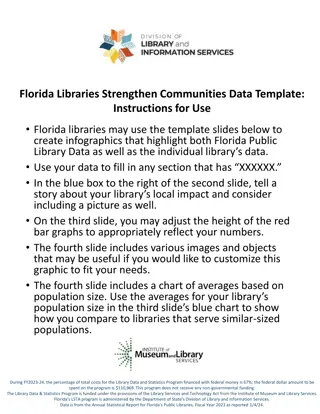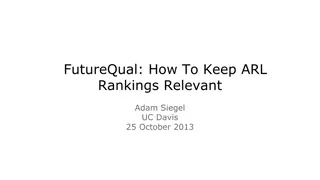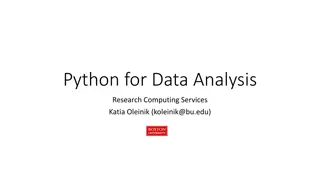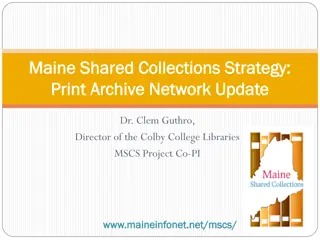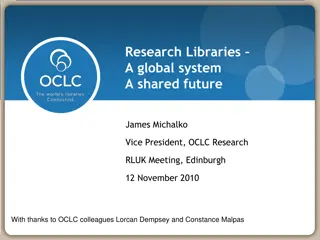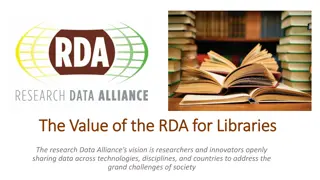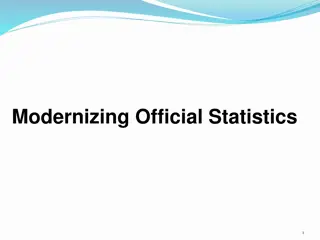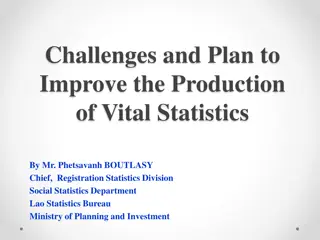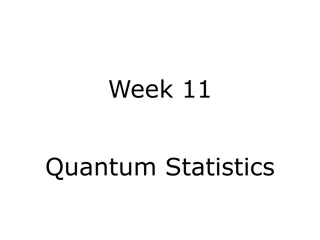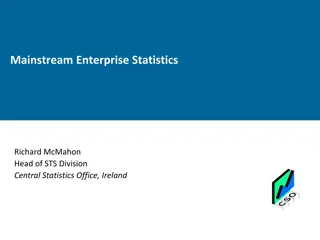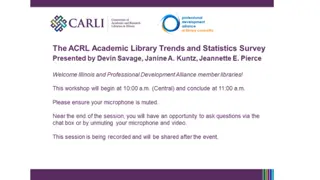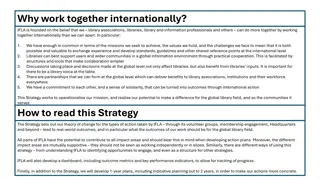Making the Most of Usage Statistics in Libraries
Explore the significance of COUNTER, guidelines for reporting electronic resource usage, and the development history of COUNTER releases. Understand the different types of measures related to COUNTER and how to gather and understand reports effectively in libraries while addressing potential issues like corrupted data.
Download Presentation

Please find below an Image/Link to download the presentation.
The content on the website is provided AS IS for your information and personal use only. It may not be sold, licensed, or shared on other websites without obtaining consent from the author. Download presentation by click this link. If you encounter any issues during the download, it is possible that the publisher has removed the file from their server.
E N D
Presentation Transcript
ENCOUNTERING COUNTER: UNDERSTANDING AND MAKING THE MOST OF USAGE STATISTICS Lydia Hofstetter, Georgia Gwinnett College John Stephens, GALILEO October 5, 2017
UNDERSTANDING COUNTER What is COUNTER? Why is it important? How can we use in the library? What are its limitations?
OVERVIEW: A BRIEF DESCRIPTION Counting Online Usage of Networked Electronic Resources. Standard guidelines for the reporting, recording, and exchange of usage data for electronic resources. Series of practice codes that address: Terminology Reports Format Processing of Usage Data What Categories Should be Available Report Delivery Compliance and Auditing Process Code Maintenance and Development Governance
OVERVIEW: DEVELOPMENT Release 1 - 2003 release, included JR1, JR2, DB1, DB2, DB3, and optional JR3 and JR4 Release 2 - 2005 release, updated to include HTML/PDF breakdowns, later added BR reports Release 3 - 2008 release, incorporation of SUSHI, updated to include federated and automated searches in DB reports, addition of consortium reports Release 4 - 2012 release, added JR 1 Gold Open Access and JR5 and required reports, added click, records views, and sessions to DB metrics Release 5 - 2017, merges and eliminates reports (mobile and consortium), move away from format-specific metrics
OVERVIEW: HISTORY COUNTER is one of several different types of measures that reflect different approaches: ARL Statistics Bibliometrics Web Metrics Altmetrics COUNTER is related in some ways to each of these. Are COUNTER stats more like gate counts or more like scholarly citations?
GATHERING Understanding Reports: i.e. Journal reports vs platform reports vs multimedia reports. Share limitations of reports with others ensuring expectation are not too high. Organization is Key: Develop a spreadsheet with login information, including administration site URL, user-names, and passwords. Build a spreadsheet listing all possible reports, COUNTER and non- COUNTER, that can provided by each vendor.
GATHERING: ISSUES Corrupted data: Track emails from vendors as they will notify if an issue has appeared. Compare data between years to check for abnormalities. Formatting problems.
GATHERING: SUSHI Standardized Usage Statistics Harvesting Initiative: Allows for automatic delivery of COUNTER data. Can facilitate large amounts of usage data. Larger vendors offer automated retrieval, but smaller vendors still require active data retrieval by library staff.
REPORTING: OVERVIEW Raw COUNTER Report Usable usage information
REPORTING: CHOOSING YOUR YEAR Different choices about the time period you choose to report your stats will affect your ability to compare resources. Calendar year (interlibrary level)- Most consistent measure outside your library and is often the default method of gathering. Fiscal year (library level)- Matches to the budget year allowing for consistency between resources. Subscription year (resource level)- helps ensure that the full date is available for each year, otherwise you will most likely have to compare prorated data.
REPORTING: WHAT IS THE COST? Determining costs is not always straightforward. The name of the resource will change over time. The way the resource is reported in COUNTER reports might not match the name on the invoice or the name by which the resource is commonly known. Bundles are particularly hard to evaluate, especially when they involve a mix of different content types (ex. both full text and abstracts only databases).
USES Assessment: Cost per use, inform renewal and purchasing information, inform faculty/ administration on the value of resources, understand user behavior. Promotion: What resources are not being used; when to highlight specific resources. Policy: How many users can access resources at once, move to more simultaneous users. Troubleshooting/Diagnostics: Compare statistics to discover unreported issue with resources. Price Negotiations: Work with vendors to achieve be cost per use.
USES: ASSESSMENT Best practice to gather three years of data. Normally, cost per use is the main measure to consider. What constitutes a use may vary and require experience with the resources. Full text is usually the best measure when available, but view and searches may provide relevant information. Other measures such as sessions and clicks may help explain unexpected cost per use numbers.
USES: PROMOTION, POLICY, AND PRICE Promotion: Develop Top Ten (25, 100) title lists. Highlight use in support of programs. Policy: Usage can be tied to funding distribution, retention policies, simultaneous vs. limited user . Price Negotiations: Declining usage can help with vendor concessions.
USES: TROUBLESHOOTING Unusual or inconsistent usage can often indicate some issues with access. Here is an example where COUNTER statistics appear to show usage of outdated links for CINAHL databases.
CONSIDERING VALUE: WHAT DOES IT MEAN? A common question is what you should consider good usage to be. Consider the following: Volume of use is only one way to measure the relative value of a journal within an institution, and it has several flaws and limitations. Our numbers game inherently favored the research interests of larger departments and research groups on the campus, journals with interdisciplinary appeal, and journals in disciplines where the primary research literature is more heavily used by undergraduate students. The value of journals representing emerging research directions, smaller departments and research groups, and disciplines in which primary literature is typically accessed only by graduate students and faculty, cannot easily be judged on the basis of use https://journals.library.ualberta.ca/eblip/index.php/EBLIP/article/v iew/28486/21047
INTERPRETING: ONE TAKE ON VALUE Good Value: $10 or less per use and at least 100 usages [$5,500 potential ILB bill and massive user inconvenience that definitely would not be worth the subscription saving]. Acceptable Value: $11-$35 per use and at least 100 usages [$5,500 potential ILB Bill and massive user inconvenience that would not justify the subscription savings] OR >$35 per use and at least 50 usages [$2,750 potential ILB bill and massive user inconvenience that would not justify the subscription savings]. Problematic Value: >$35 per use and less than 50 usages OR $10 or less per use at least 30 usages [$1,650 potential ILB bill and would not meet the University Library s traditional STEM cancellation standards and probably not be acceptable to Academic Affairs faculty].
INTERPRETING: ONE TAKE ON VALUE Low Value: 11-$35 per use and at least 30 usages [$1,650 potential ILB bill and could be justified in term of cost-effectives in an extreme budget scenario and should be acceptable to faculty] Unacceptable Value: <30 usages regardless of price [minimal user inconvenience and completely justified as the ILB bill would certainly be much lower than subscribing and cancellation would acceptable to users as both a practical and political matter]. (ERIL-L discussion post by Luke Swindler/UNC) http://lists.eril- l.org/htdig.cgi/eril-l-eril-l.org/2015-August/000254.html
INTERPRETING: GENERAL CONSIDERATIONS Cost/use will tend to be lower for large interdisciplinary packages. An acceptable cost/use might be higher for subject specific collections. Comparing cost/use is most straightforward when done between collection from the same vendor or with the same general scope.


